Olive Harvesting in Greece

This post is also available in:
This post is also available in:
![]() Deutsch (German)
Deutsch (German) ![]() Nederlands (Dutch)
Nederlands (Dutch) ![]() العربية (Arabic)
العربية (Arabic) ![]() 简体中文 (Chinese (Simplified))
简体中文 (Chinese (Simplified)) ![]() Italiano (Italian)
Italiano (Italian) ![]() Ελληνικά (Greek)
Ελληνικά (Greek)
Chania, Crete: Pamako olive oil and Eftychios Androulakis made Tsounati olive variety famous
Despite the common belief that Tsounati cannot produce olive oil of high quality, but always with his father’s support, Eftychios Androulakis managed to create Pamako and conquer the national and global market. The monovarietal olive oil from Tsounati and the blend of 60% Tsounati and 40% Koroneiki are now prescribed as a food supplement in Belgium, thanks to their phenolic content that reaches 1,800 mg/kg. In an organic olive grove with a steep slope and an altitude of 500 to 700 meters, Mr. Androulakis cultivates 10,000 trees of Koroneiki variety and 4,000 olive trees of Tsounati variety, between 300 and 1,000 years old, reach 15 and even 20 meters in height.
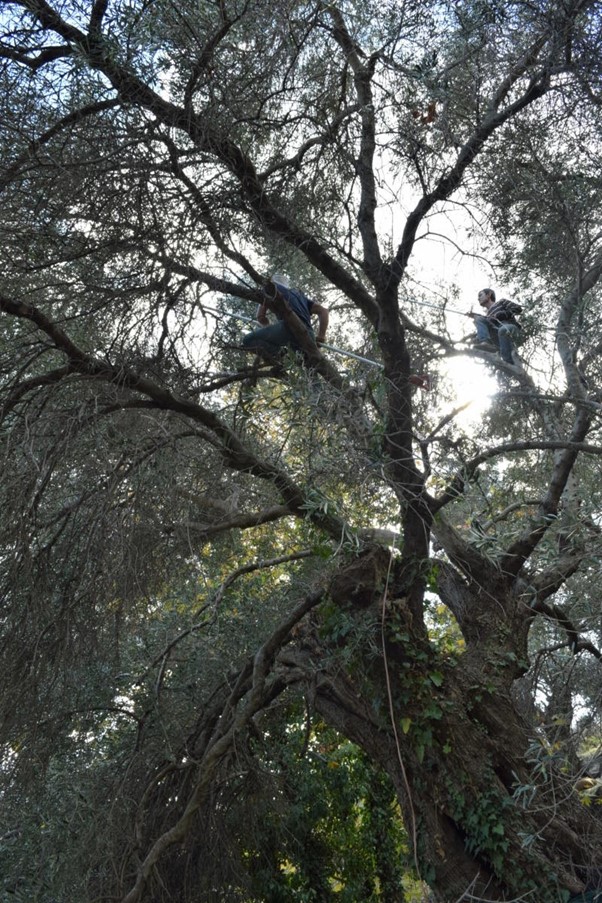 Harvesting the olive from both varieties usually starts on 20th September, but the severe dry spell of the summer of 2021 will force the farmer to start the process a bit later this year (5th of October). At that time, the olives have a green-yellow skin color. Analysis results of small amounts of oil extraction (100 ml), which give data like the oil concentration and its organoleptic characteristics in different moments, point out the exact harvest moment. Due to the extreme height of Tsounati trees, the geomorphology of the farm orchard, harvesting is quite tricky, with the workers climbing, in many cases, with ropes on the trees. To protect the quality of the product and the environment, Mr. Androulakis chooses to use only battery-running vibrating harvesters with a hook. Two weeks after harvest is completed, the producer applies to his field, compost of his production. Pruning takes place two months later, with the farmer choosing to remove the minimum amount of branches from Tsounati trees. Except for the meticulous cultivation methods implemented, the excellent quality of Pamako olive oil is also the result of constant experimentation at the oil mill cooperating with the oil expert Mr. Michali Marako. In parallel with olive cultivation, Mr. Androulakis engages himself with modifications of the machines in the oil mill. In fact, his last invention, a new system of washing and drying of olives that reduces the temperature of the fruit by 2 to 3 degrees, is now in a patenting process.
Harvesting the olive from both varieties usually starts on 20th September, but the severe dry spell of the summer of 2021 will force the farmer to start the process a bit later this year (5th of October). At that time, the olives have a green-yellow skin color. Analysis results of small amounts of oil extraction (100 ml), which give data like the oil concentration and its organoleptic characteristics in different moments, point out the exact harvest moment. Due to the extreme height of Tsounati trees, the geomorphology of the farm orchard, harvesting is quite tricky, with the workers climbing, in many cases, with ropes on the trees. To protect the quality of the product and the environment, Mr. Androulakis chooses to use only battery-running vibrating harvesters with a hook. Two weeks after harvest is completed, the producer applies to his field, compost of his production. Pruning takes place two months later, with the farmer choosing to remove the minimum amount of branches from Tsounati trees. Except for the meticulous cultivation methods implemented, the excellent quality of Pamako olive oil is also the result of constant experimentation at the oil mill cooperating with the oil expert Mr. Michali Marako. In parallel with olive cultivation, Mr. Androulakis engages himself with modifications of the machines in the oil mill. In fact, his last invention, a new system of washing and drying of olives that reduces the temperature of the fruit by 2 to 3 degrees, is now in a patenting process.
Makri, Alexandoupoli: The protected name of origin Makri variety and an ideal microclimate create the high-quality Cyclops olive oil.
The family orchard of 12,000 centuries-old trees is located close to the sea, in one of the northern parts of Greece, where olive trees grow. Enriching the family business with a private olive mill in 1982 and applying cultivation techniques of an integrated management system, the farmers of Cyclops (Kyklopas in Greek) managed to produce an extra virgin olive oil that reached the top ten in world quality ranking. Organic farming is applied in 2,000 tress, while the yield strongly fluctuates due to alternate bearing. “The last 10-15 years, we start the harvest earlier, at mid-October, to give extra value to the final product. We see that more and more olive producers in the area tend lately to follow that trend,” they mention at Wikifarmer team. The oil content analysis of the fruits gives a harvest signal. Vibrating trunk machines and nets, as well as vibrating olive harvesters with a hook, are employed. “The olives have to be temporarily stored in crates (with a storage capacity of 20 kilos-44 pounds) since they ensure better airing of the fruit,” states the farmer.
Ofrinio, Kavala: Use of gloves during harvest protects the precious Xalkidiki olives of Michalis Nikos
An irrigated olive orchard of 3,500 trees of the indigenous Xalkidikis variety (or Hondroelia Halkidikis) produces the exceptional olive oil Εnnέα and the almond-sized olive fruits. The farmer categorizes the fruits based on their final size and uses the smaller ones (200 pieces per kilo and above) for early harvest olive oil (agoureleo) production. The larger ones are sold as table olives. Mr. Nikos does not apply any fruit thinning. Instead, he mechanically reduces the excessive flowers early in the season (April-May). Sometimes, the farmer sprays with chemicals to promote fruit production. Thanks to proper pruning and irrigation, the trees offer a stable production every year, with no dramatic alternate bearing.
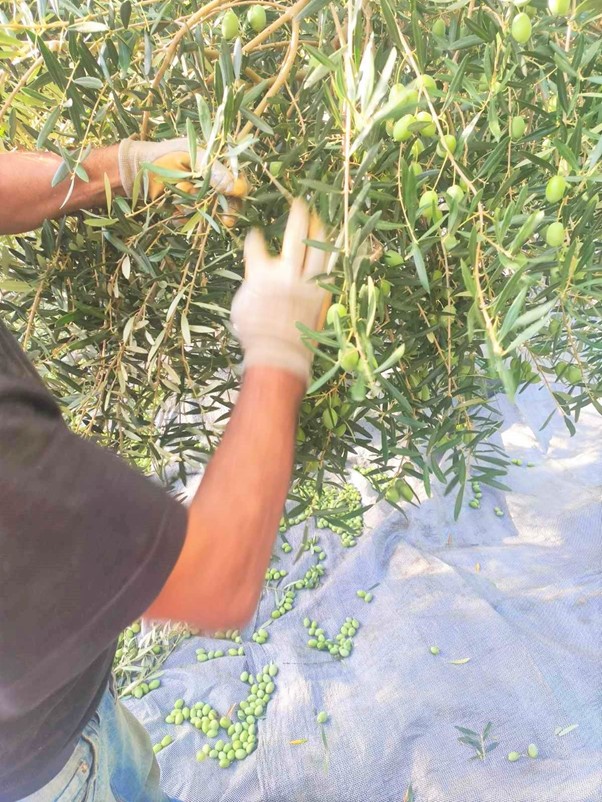 Harvesting takes place in mid-autumn (late September and October) and is done strictly by hand. Workers wear gloves or protective tapes on their fingernails to prevent injuring the sensitive olives. The farmer prunes his trees later, from February 25th to March 10th. “Due to irrigation, the trees exhibit a strong and vivid shoot growth, which we need to control yearly with a good pruning. We also remove the suckers (vigorous shoots) and the water shoots during July.”, the farmer mentions.
Harvesting takes place in mid-autumn (late September and October) and is done strictly by hand. Workers wear gloves or protective tapes on their fingernails to prevent injuring the sensitive olives. The farmer prunes his trees later, from February 25th to March 10th. “Due to irrigation, the trees exhibit a strong and vivid shoot growth, which we need to control yearly with a good pruning. We also remove the suckers (vigorous shoots) and the water shoots during July.”, the farmer mentions.
Arkaloxori, Heraklion: Love, respect for the tree and constant training are the recipe of the unique Seven Olea olive oil.
The extra virgin olive oil Seven Olea, with a health claim, is produced from 370 trees of Koroneiki variety in the area of Arkalochori, Crete. The trees are 50, 30, and 20 years old and grow organically in a rain feed olive grove. The harvest occurs in late October to early November after the first rains (but not in wet-humid environmental conditions). That way, the branches gain elasticity and do not get injured or broken during the process. “In general, the ideal time for harvesting is when the fruit has reached a ripeness index of 2. At that moment, we can achieve maximum oil content and high phenolic concentration in the fruits. Visually this maturation stage can be defined when the purple color covers less than 50% of the fruit peel. “, the farmer, Manos Kokkinelis, declares. “Our goal is to produce a high-quality product by doing what we love the most.”, he continues. According to Mr. Kokkinelis, when deciding the harvest time, every farmer should take into account the location of the olive grove (e.g., altitude). Furthermore, it is crucial to determine if the production is at risk due to extreme weather or a disease-enemy outbreak. In that case, the harvest should start from there. If two people pick the olives per tree, they should start from the same spot and move in a circle and in a counter-diametrically way to not step on the fallen fruits. Under no circumstances should plastic or jute bags be used. Instead, the farmer can gather the olives in plastic crates, where a better airflow is succeeded. The search for a good olive mill is crucial as the oil extraction process can dramatically affect the quality of the final product (quality degradation up to 50%). In conclusion, Mr. Kokkinelis stressed the importance of constant training of olive growers and the need to join forces by creating producer Cooperations. Finally, implementing good agricultural practices and the standardization of olive oil can add significant value to the final product.
Messara, Crete: Implementation of well-studied techniques is the secret of ἔ.thoς of Crete and Markos Kelly’s success.
In the most south part of Greece, the family of Markos Kelly produces an olive oil that travels from Scandinavia to Great Britain and soon to Japan and the USA. The 35,000 square meters (3.5 hectares) olive grove, with Koroneiki, lies at the foot of the Asterousia mountains at an altitude of 250-300 meters (980 feet). Being a 6th generation olive grower and constantly striving to enrich his knowledge, Mr. Markos Kelly chooses to pursue quality over quantity and to “lock” the fruity aromas in his olive oil by harvesting on October 20th with pneumatic olive harvesters.
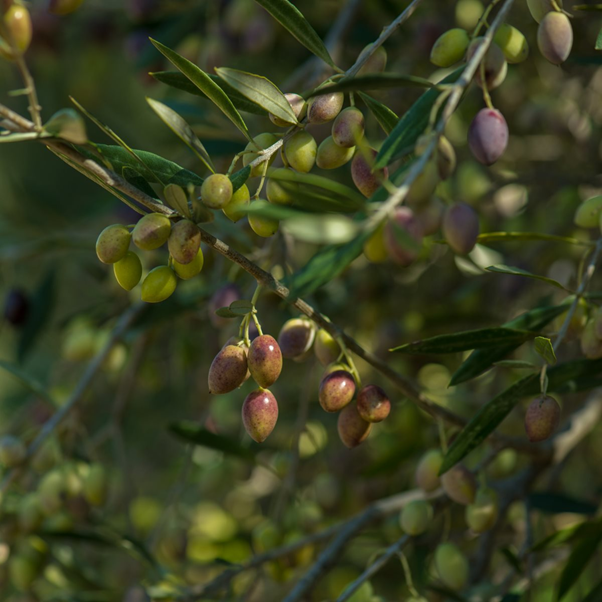 The initiation of purple coloring on the fruit peel and the micro oil extractions giving data about the oil content, the phenols and the organoleptic characteristics, provide a double and reliable signal for harvesting. “It is still quite common to see people collecting the olives from the trees in January, even in March. This technique can dramatically reduce both the quality of the fruit and the yield of the next season. The small, fragmented farmland and the lack of workers delay the harvest.” the farmer mentions. After harvest and by using only crates to move the fruits to the oil mill, the extraction of the olive oil starts within 5 hours.
The initiation of purple coloring on the fruit peel and the micro oil extractions giving data about the oil content, the phenols and the organoleptic characteristics, provide a double and reliable signal for harvesting. “It is still quite common to see people collecting the olives from the trees in January, even in March. This technique can dramatically reduce both the quality of the fruit and the yield of the next season. The small, fragmented farmland and the lack of workers delay the harvest.” the farmer mentions. After harvest and by using only crates to move the fruits to the oil mill, the extraction of the olive oil starts within 5 hours.
Apollo, Rhodes: Gianna Leventi harvests at the start of November
With conventional cultivation methods and no irrigation grow the 2,000 trees of Koroneiki and Rhodes varieties, aged 20-80 years, that gives the Rodian Olive Oil Products. Strong alternate bearing is a common problem on the island, says the farmer Gianna Leventi. The harvest starts in November and lasts until January, by using only vibrating harvesters with a hook.
Plomari, Lesvos: Olive groves on steep slopes and the late-maturing Kolovi variety produce a rich olive oil with great heritage.
Each variety cultivated in the island has its own maturation time, but Kolovi is the latest, explains the farmer Apostolos Toumanis that cultivates 4,000 trees of it. “It is a common mistake to leave the olives on the trees long after their maturation and believe that they produce more oil. This way, the quality of the product decreases, and the production of next year is also at stake.” says the farmer.
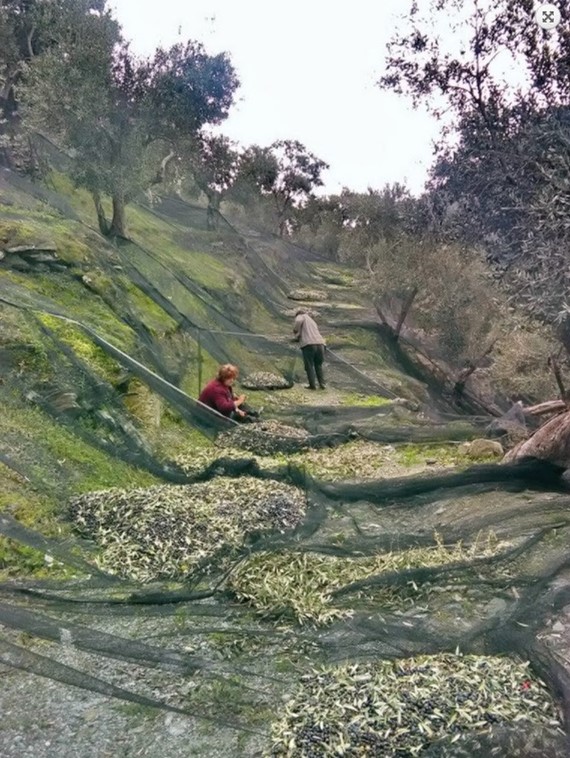 To produce a green olive oil (agoureleo) rich in polyphenols and aromas, Mr. Toumanis starts harvesting the olives in November. In years that the trees are not overloaded with olives, the harvest might start a bit later. Like most other activities, harvesting is also challenging in the olive groves of the island due to the steep slope the ground has. The only suitable equipment in these circumstances is the handheld vibrating harvesters (with a hook). Pruning happens in 10-15th of March (or later). By using mainly hand-moved saws and scissors and removing the minimum possible amount of branches, pruning is a very delicate work for Mr. Toumanis. More heavy pruning with chain saws is applied every 3-4 years to reduce the height of the trees.
To produce a green olive oil (agoureleo) rich in polyphenols and aromas, Mr. Toumanis starts harvesting the olives in November. In years that the trees are not overloaded with olives, the harvest might start a bit later. Like most other activities, harvesting is also challenging in the olive groves of the island due to the steep slope the ground has. The only suitable equipment in these circumstances is the handheld vibrating harvesters (with a hook). Pruning happens in 10-15th of March (or later). By using mainly hand-moved saws and scissors and removing the minimum possible amount of branches, pruning is a very delicate work for Mr. Toumanis. More heavy pruning with chain saws is applied every 3-4 years to reduce the height of the trees.
Stylida, Phthiotida: Harvest only by hands to produce the “golden” Amfora Icons olive oil
With a century experience, olive farming is a family tradition for Mr. Giorgos Mpalatsos. The olive grove of 10,000 trees of Amfissis variety, 100-600 years old, is located in Othris mountain. The fruits produced are used both as table olives and for oil extraction. The trees exhibit a strong tolerance to drought and temperature fluctuations, and despite their mid productivity, the olive fruits are of high quality and rich in sugars. To secure this superior quality and create a premium olive oil, Mr. Mpalatsos harvests 2,000 of his trees by hand in the second half of October.
![]() “We collect the olive fruits when they are between the maturation stages three and five, when the color of the peel changes from yellow to light purple. We selected to harvest at that point because we want a high concentration of polyphenols and a rich flavor.”, explains the farmer. On the contrary, the table olives are harvested green at September, by hand and vibrating harvester with a hook. Based on the environmental condition and weather forecast, the farmer prunes his trees during January-February, to avoid frost damage.
“We collect the olive fruits when they are between the maturation stages three and five, when the color of the peel changes from yellow to light purple. We selected to harvest at that point because we want a high concentration of polyphenols and a rich flavor.”, explains the farmer. On the contrary, the table olives are harvested green at September, by hand and vibrating harvester with a hook. Based on the environmental condition and weather forecast, the farmer prunes his trees during January-February, to avoid frost damage.
Stylida, Phthiotida: In international markets as a standardized product, 90% of the Konservolia table olives of Stylis Olive Producers Cooperation members.
The 750 members of the Cooperation produce green and black Konservolia olives based on an integrated management system. The majority of the olive groves have a steep slope (up to 20ο), making the harvest tedious and the use of tractor-moved machinery almost impossible. By hands, comb, or vibrating harvesters, farmers start collecting the green olives after the first rains of September. The more sensitive black olive fruits are collected later, exclusively by hand. No fruit thinning is required. Most of the farmers prune their trees in March.
Itea, Fokida: “We need to step away of the obsolete techniques and beliefs.”, emphasizes the farmer Panagiotis Danatzis.
The olive trees of Panagiotis Danatzis are part of the largest continuous traditional olive grove of the Balkans, protected by UNESCO. The farmer has decided to use a table olive variety, like Amfissis, to produce a premium olive oil, the “Socrates.” “We are aware that the oil we will get is going to be few, but the quality of the product rewards us. We need 12-13 kilos (28 pounds) to extract 1 kilo (2.204 pounds) of olive oil.”, mentions Mr. Danatzis. Most of the olive farmers in the area are used to harvest at the end of February. When Mr. Danatzis started harvesting the olives seven years ago at the end of September, everyone thought he was crazy. “For me, it was easy to apply the correct techniques and fresh ideas from the start because I didn’t have any prior experience. I understand that for older farmers, the transition to an early harvest is still unthinkable or at least more difficult. However, it is essential for the Greek olive oil sector to invest in quality since we cannot compete with countries like Spain or Turkey in quantity.”, says the farmer.
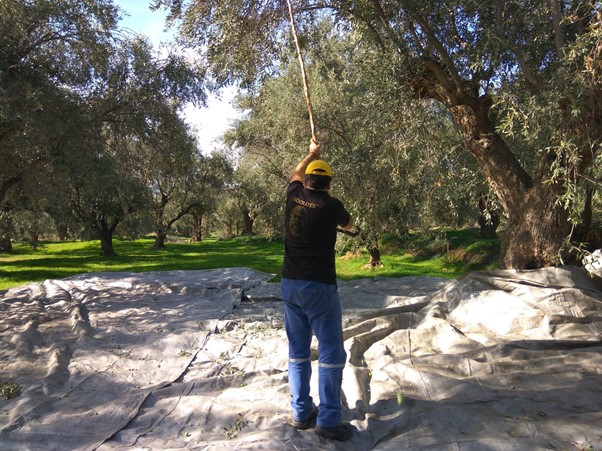 For maintaining the good health and quality of the olives, the harvest takes place when the environmental conditions allow it (no rain for 2-3 days before and after the harvest). In the region, from ancient times to even 20 years ago, most people were using wooden sticks to collect the olives from the tress. Lately, more and more farmers, like Mr. Danatzis, have chosen to move towards a more mechanized harvest using vibrating harvesters with a hook.
For maintaining the good health and quality of the olives, the harvest takes place when the environmental conditions allow it (no rain for 2-3 days before and after the harvest). In the region, from ancient times to even 20 years ago, most people were using wooden sticks to collect the olives from the tress. Lately, more and more farmers, like Mr. Danatzis, have chosen to move towards a more mechanized harvest using vibrating harvesters with a hook.
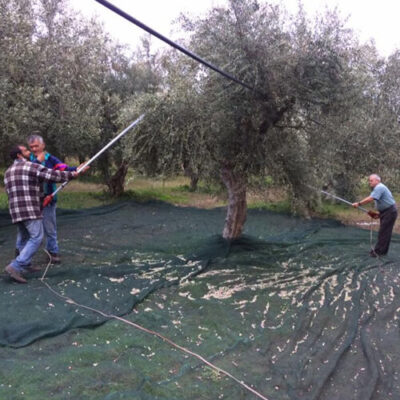 Messolonghi, Etoloakarnania: The goal of Panagiotis Papachristos is to leave 50 kilos of olives per tree after fruit thinning.
Messolonghi, Etoloakarnania: The goal of Panagiotis Papachristos is to leave 50 kilos of olives per tree after fruit thinning.
In a semi-mountainous olive grove with slope is located the Kakkavos estate with 7,000 trees of Koroneiki, Koutsourelia, and Kalamon varieties. Irrigation is applied in 50% of the olive trees, while all of them are cultivated with an organic system. To achieve larger table olives with great quality characteristics, the farmer applies fruit thinning in Kalamon, aiming at a final yield of 50 kilos (110 pounds) of olives per tree. For producing green olive oil, Mr. Papachristos continues the family tradition and harvest at the start of October, while for the table olives, the harvest starts at the end of the same month. In both cases, the farmer uses hand-held vibrating machines. When the process is completed, spaying the trees with copper will protect them from any fungal infection, explains the farmer.
Trikeri, Magnisia: Early harvest and an ideal micro-climate “shape” the special “Aladanon” olive oil of Mr. Aris Sarhgiannis.
The organic olive grove with 3,500 trees of Piliou variety is located in a rocky, dry land covered with ladanum. The exceptional micro-climate of the area seems to be responsible for the unique characteristics of the “Aladanon” olive oil, explains the farmer Mr. Sarhgiannis. Interestingly, the content of polyphenols (with more than 450 mg/kg) in the olive fruits produced from this farm is much higher compared to another olive grove that the farmer cultivates with the exact same techniques and variety, in another field. “When the olive becomes black, we are losing the precious polyphenols.”, says the farmer, who chooses to harvest early.
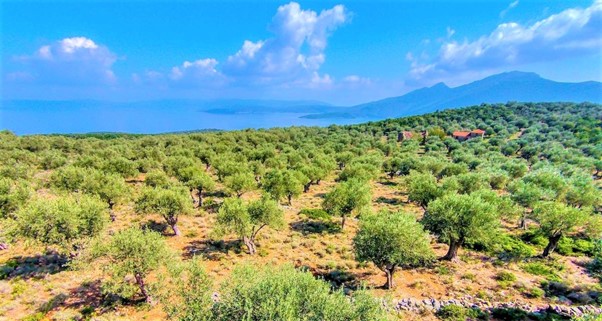 Before the dry spell and the heatwave of summer 2021, the plan of Mr. Sarigiannis was to harvest at the end of August. With the new data, he decided to start in October, even later than he used to. As for the olives that will be used for oil production, so for the harvest of the table olives, a 12V battery sea urchin olive harvester machine is used. The farmer has noticed that no measurable damage is caused in the peel of the table olives with this method. After the harvest, the olives are placed in crates in a cool, shaded place. The oil extraction process usually starts within the same day or the morning of the next. Knowing that pruning with or right after harvest will put hid trees in danger during winter, Mr. Sarigiannis waits until March to remove at least the suckers.
Before the dry spell and the heatwave of summer 2021, the plan of Mr. Sarigiannis was to harvest at the end of August. With the new data, he decided to start in October, even later than he used to. As for the olives that will be used for oil production, so for the harvest of the table olives, a 12V battery sea urchin olive harvester machine is used. The farmer has noticed that no measurable damage is caused in the peel of the table olives with this method. After the harvest, the olives are placed in crates in a cool, shaded place. The oil extraction process usually starts within the same day or the morning of the next. Knowing that pruning with or right after harvest will put hid trees in danger during winter, Mr. Sarigiannis waits until March to remove at least the suckers.
Paliabela, Vonitsas: Εxperimentation with the time and way of harvest, are constantly upgrading the Agalis olive oil of Nikolas Stogiannos.
In Paliabela, only 750 meters from the seaside, one can find the 4,000 young, rain feed trees of the Koroneiki variety that produce the olive oil Agalis. The harvesting period for Mr. Stogiannos starts at the end of October-beginning of November, from the part of the olive grove that is located on rocky ground with a slope. Despite the low content in oil (11%), the olives at this stage (with yellowish peel color) offer a rich and unique taste at the final product. The harvest continues at the part of the grove where the farmer worries the most about a possible disease outbreak or where the yield is the highest. That way, he ensures a large part of his production. As a result, at the end of the harvest season, the farmer creates a blend with the oil extracted from 50% yellow fruit and 50% black fruit.” Combining the olive oil of an early harvest with that extracted from more mature and ripe olives, we have a final product with aromas, mild flavor and a satisfying phenolic content that our customers prefer.”, mentions the farmer. Additionally, Mr. Stogiannos, troubled with the lack of available, skillful workers, will test for the first time (in 2021) a new harvester attached to a tractor. The pruning takes place in February, while the prolonged drought phenomena of recent years worry Mr. Stogiannos, who is considering the possibility of turning his olive grove into an irrigated one.
Schimatari, Biotia: “We harvest at mid-October since even two weeks delay increases the acidity of the olive oil produced.”, say Marina Korlou and Kostas Tasias.
The excellent quality of Aulis olive oil is not by chance but is the result of the continuous hard work of the two farmers, Marina Korlou and Kostas Tasias. The olive grove in Schimatari consists of 200 trees of Megaritiki and Evia varieties, aged from 40 to 50 years. The two young farmers aiming at producing an olive oil with very low acidity, rich in phenols, aromas, and flavor, decided to harvest during the second half of October. However, the unexpected early rainfalls at the end of September 2021 allowed them to start the process a bit earlier this year. “Harvesting in time (or earlier) is crucial for the quality of the olive oil since even a delay of two weeks can increase the acidity 0.2%.”, explains Mr. Tasias. The olives are collected with pneumatic olive harvesters and are placed in craters. The oil extraction starts the afternoon of the same day of the harvest or in the morning of the day after. Finally, the farmers mentioned that due to the more common late frosts of the past few years, they delay pruning their trees. In fact, the heavy snowing at the end of February 2021 forced them to prune in March.
Lixouri, Kefalonia: With practices based on the biodynamic system Ms. Eleni Skafida produces Ellia’s Organics.
Continuing the family tradition, the young farmer cultivates 100 olive trees of Koroneiki, Korfolia, and Ntopia varieties, of 50 years old. All trees grow with strictly organic methods, and as Ms. Skafida mentioned, they suffer from intense alternate bearing. Harvest starts in mid-October, like in most olive groves of the island, and lasts around a month. “We would ideally like to harvest 2-3 weeks earlier, but the low oil content of the fruits is still quite low based on our needs.”, explains the farmer. The whole process is slow and is executed by hands (milking) and hand-moved plastic olive rakes. In some cases, she cuts off some branches filled with olives and put them in a separator machine placed in the ground to collect the fruit. Finally, the family prunes the tress during February.
Trizina, Argolis: Earlier the harvest, stronger the fruit detachment force, explains Mr. Thanos Tsigras.
With an olive grove of 9 hectares, of Manaki and Koroneiki trees, scattered in the area of Trizina, Mr. Tsigras produces the organic olive oil Theseus. Some of the trees are irrigated, and some others are not. Aiming to produce high-quality olive oil, the farmer chooses to harvest early, starting at the 10-20th of October for the Manaki trees and around 5-10th of November for the more late Koroneiki trees. However, this year’s prolonged drought seems to delay the olive maturation, as the fruits, in the arid trees, are dehydrated. “We are waiting for the rain. Then it will be easier to determine the exact date we will start harvesting.”, says the farmer. Despite that, early harvesting has many benefits for the quality and the organoleptic profile of olive oil, it also comes with a problem. The high detachment force of the premature olives makes harvest more difficult, forcing the farmer to increase the vibration of the pneumatic harvesters used. These new settings cause extensive loss of leaves, something that worries the farmer. After harvest, Mr. Katsigras sprays his trees with copper and prunes them later in January.
Astros Kynourias: “The olives mature earlier each year”, says Ms. Antonia Ksenou
The 300 trees of the variety Xontroelia Kynourias produce mammoth, high-quality olives that reach the market with the brand name Olivitsa. According to the farmer, the trees have a high water demand, so establishing an irrigation system in the olive grove was the only option. Alternate bearing is not severe, but in the years with significant fruit load, Ms. Ksenoy performs an early fruit thinning. “Traditionally, we started harvesting the olives in mid-October. However, we have noticed that the olives mature more and more early in the past few years, moving the harvest day around the end of October.”, says the farmer. Ms. Ksenou prefers to harvest traditionally, by hand, to avoid causing any injuries to the olives. The processing of table olives collected takes place in special barrels, without acids and chemical preservatives. Every year, during February, the farmer applies only a light pruning of the trees, while, once every two years, she performs a more strict pruning.
Krokees, Lakonia: Increasing the value of the product by cultivating organically.
Mr. Eythymios Xristakos decided to change the cultivation system applied to his 3,000 olive trees from conventional to organic. The over 600 years-old olive grove has trees from three different varieties, Koroneiki, Smyrtolia and Kalamon, with the olives of the latter to be used both as table olives and for the production of olive oil. For the production of early harvest olive oil, rich in polyphenols, the harvest starts mid-October, based on micro-oil extractions. For a more mild-flavored olive oil, the farmer uses fruits that have been harvested in mid-November. In both cases, he collects the olives by using vibrating harvesters with a hook. To help his trees produce bigger and more well-formed table olive, Mr. Christakos applies fruit thinning in Kalamon trees. Pruning takes place right after the harvest. Although the farmer recognizes that combining these activities is not the most appropriate-suitable technique, he believes that the mild winters in the area allow such a practice.
Gythio, Lakonia: Harvesting the olives early, Helianna Zafeirakou and Dimitris Tsitsos noticed a yield increase.
The personal love of both farmers for the taste of green oil (agoureleo or early harvest olive oil) convinced them to try an early harvest in one third (1/3) of their trees. The result; Consumers loved it. The olive grove responsible for this exceptional final product is located a few meters from the sea, in the south part of Peloponnese. It has 800 trees of Koroneiki and 200 trees of Kalamon variety, over a century old, that grow without irrigation and organically. The young couple chooses not to use any chemical fertilization or tillage. Instead, they apply an organic compost of the leaves and chipped branches produced during pruning, a technique that increase the soil’s water availability. ” It was surprising to see trees that have not produced any olives for years, to yield again.”, says Mr. Tsitos. Usually, the harvest starts the first days of November from Koroneiki trees, when the olive fruit is still green. Next in line is Kalamon, while the harvest of the olive grove is completed by collecting the last Koroneiki black olives from the trees. Zafeirakou family uses, like most farmers nowadays, vibrating harvesters with a hook. Until they buy crates, the farmers collect the harvested olives in jute sacks and empty them into containers when they arrive at the oil mill. Finally, they prune the trees immediately after harvest since, as they say, it is more convenient.
Filiatra, Messinia: “The olives mature earlier due to the micro-climate of the area,” says Basilis Kitsos.
Despite the many years of experience with the crop, Mr. Kitsos decided to follow the modern trend and harvest early. The Messinian Farm has over 4,000 olive trees of Koroneiki, with most of them to be irrigated, located in plain and hills. The average age is 70 years, with the oldest ones are 200 years old. To produce the precious green oil, and with the help of the area’s micro-climate, the harvest starts when the color of the olive peel changes from green to yellow. This maturation level occurs around the 20th of September. The farmer uses pneumatic harvesters to collect the olives from the trees. As a complementary method, he prunes some branches filled with olive fruits and uses a machine in the ground to separate the olives from the leaves and stems. To protect his trees after the harvest from fungal infections, he sprays them with copper.
Labena Messinia: “We can get a tasty and phenol rich olive oil even from dehydrated olives.”, says Athanasios Theodoropoulos.
Most farmers think there is no reason to harvest the olives that looks wrinkled and dehydrated. However, Mr. Theodoropoulos has a different opinion and the exceptional quality of the Lezi olive oil he produces, confirm that he is right. The olive grove of the Theodoropoulos family numbers almost 2000 olive trees of Koroneiki variety. More than 1,700 of them are located on the mountain, and their age ranges between 60-80 years, while there are, of course, several centuries-old trees. The rest of the olive trees are spread in the plain and are irrigated. Although he is a 3rd generation olive grower, he had never seen anyone in the area harvesting before the 6th of December.
 Things changed radically for the farmer four years ago. An extremely early year, combined with the growing belief that “the sooner, the better,” led Mr. Theodoropoulos to harvest on the 20th of October. The final amount of oil was a bit lower, but the quality improvement was astonishing. While at first, most of the farmers laughed at him, soon they were convinced by the results and followed his example. After that, the harvest always starts at the end of October, from the trees in the plain. Fifteen days later, after the first autumn rains, the farmer continues with the rain-feed trees in the mountains. In both cases, he uses a sea urchin olive harvester machine with an electric generator. The lack of rain from February until October 2021 stressed the trees in the mountains. “The olives might look wrinkled, but they still can give a high-quality oil.”, admits the farmer. The steep slope of the grove makes the use of crates difficult, and for that reason, the farmer gathers the olives in jute sacks. The extraction of the oil happens within a day from the harvest.
Things changed radically for the farmer four years ago. An extremely early year, combined with the growing belief that “the sooner, the better,” led Mr. Theodoropoulos to harvest on the 20th of October. The final amount of oil was a bit lower, but the quality improvement was astonishing. While at first, most of the farmers laughed at him, soon they were convinced by the results and followed his example. After that, the harvest always starts at the end of October, from the trees in the plain. Fifteen days later, after the first autumn rains, the farmer continues with the rain-feed trees in the mountains. In both cases, he uses a sea urchin olive harvester machine with an electric generator. The lack of rain from February until October 2021 stressed the trees in the mountains. “The olives might look wrinkled, but they still can give a high-quality oil.”, admits the farmer. The steep slope of the grove makes the use of crates difficult, and for that reason, the farmer gathers the olives in jute sacks. The extraction of the oil happens within a day from the harvest.
Agios Mattheos, Corfu: A world record in phenols content for The Governor olive produced from Lianolia variety.
In Corfu, 65% of the total plants are olive trees. The island’s olive grove, with the indigenous variety called Lianolia, is categorized among the oldest of such size in the world (400-1,500 years old trees). Despite the long tradition in olive cultivation, no specialization or improvement of the methods used is observed. Most farmers lay nets in the ground in November and collect the over-matured fruits that fall naturally from the trees until June. Not long ago, people also believed that during malaxation, the temperature should be extremely high. Having experienced the decay of the olive cultivation, Spyros Dafnis decided to travel abroad and to obtain new knowledge that he could implement in his olive grove. “The first year, the result was still disappointing, and we realized that more effort is needed to be as precise as possible. After two years, a chemical analysis of our olive oil surprised everyone. “The Governor” olive oil stood out in the Olympia Awards 2016, breaking a world record in total phenol content (2,377mg/kg), with 980 mg/kg oleocanthal concentration.”, explains Mr. Dafnis. Now, the family olive grove numbers 10,000 trees of Lianolia variety and almost 2,500 of Koroneiki. “The trees look more like a forest. Many of them were abandoned for years and reach 15-20 meters (49-65 feet) in height. We are trying to lower them by pruning, but that takes a long time. To harvest the olives from such tall trees, we use a trunk saker, and we apply the vibration in the largest branches.
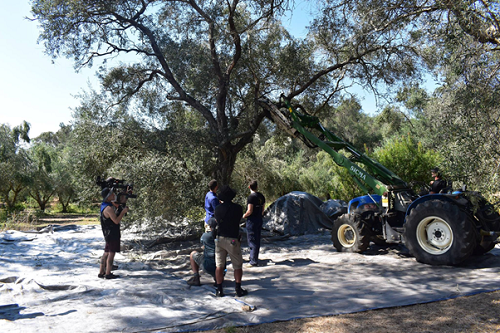 The unusually high temperatures, even in October, of the past two years, consist of one of the farmers’ most important problems. “Last year, we experimented by harvesting and doing oil extractions late in the afternoon or very early in the morning to protect the quality of our product. This year, we are also considering using a refrigerator truck to transport the olives from the field to the oil mill. The oil extraction takes place within 2-4 hours from the harvest in our private oil mill located in the heart of the olive grove” Mr. Dafnis mentions.
The unusually high temperatures, even in October, of the past two years, consist of one of the farmers’ most important problems. “Last year, we experimented by harvesting and doing oil extractions late in the afternoon or very early in the morning to protect the quality of our product. This year, we are also considering using a refrigerator truck to transport the olives from the field to the oil mill. The oil extraction takes place within 2-4 hours from the harvest in our private oil mill located in the heart of the olive grove” Mr. Dafnis mentions.








































































